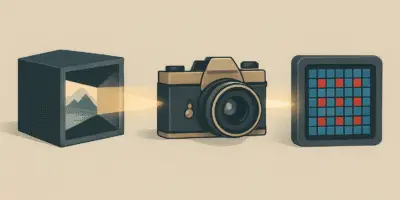Let’s be real here – most of us have a pretty simple understanding of how deleting files works. You select a file, hit delete, and poof! It’s gone forever… right? Trust me, it’s not that simple.
Today, I’m going to bust one of the most common tech myths that could actually put your personal data at risk. As someone who’s had to learn this the hard way, I can tell you – understanding how file deletion actually works might just save you from some serious privacy headaches down the road.
Table of Contents
The Surprising Truth About “Deleted” Files
Here’s the thing that blew my mind when I first learned about it: when you delete a file from your hard drive or flash memory, it doesn’t actually disappear. Crazy, right?
Most of us have no idea that these supposedly “deleted” files can be recovered quite easily. This happens because they aren’t truly deleted at all – they’ve just temporarily vanished from view, but they’re still lurking in your storage device, waiting to be discovered.
The Three Types of File Deletion
Before we dive deeper, let’s clear up what’s actually happening when you delete something by breaking down the three different types of deletion:
1. Simple Deletion (Not Really Deletion)
When you select a file and press the Delete key, you’re not deleting anything at all. You’re simply moving the file to the Recycle Bin or Trash folder. It’s like taking something out of your desk drawer and putting it in your wastepaper basket – it’s still in your room, just in a different place.
Getting files back from this state is ridiculously easy – just open your Recycle Bin, find the file, and click “Restore.” No magic required!
2. Semi-Permanent Deletion
This happens when you:
- Select a file and press Shift+Delete
- Delete something that’s already in the Recycle Bin
- Empty your Recycle Bin
At this point, the file disappears completely from view – no Recycle Bin safety net. But here’s where it gets interesting…
3. Permanent Deletion
This is the real deal – when the data is genuinely gone for good. But this rarely happens through normal deletion methods, and I’ll explain why in a minute.
How Hard Drives Actually Work (The Geeky Explanation)
To understand why “deleted” files stick around, we need to take a quick peek under the hood of your hard drive.
Your hard drive is divided into tiny sections called “sectors.” These sectors store your data – photos, videos, documents, everything – but not in the form you’d recognize. Everything on your computer is actually stored as binary code (those famous ones and zeros – like 01100101).
When you view a photo, your operating system (like Windows) translates this code back into a visible image. Pretty neat, huh?
Now here’s the crucial part: when you perform a semi-permanent deletion (Shift+Delete or emptying the Recycle Bin), the system doesn’t actually erase the binary code. It simply marks that sector as “rewritable,” meaning it can be used for new data.
It’s like having a notebook where you don’t erase the old notes – you just put a sticky note on the page saying “feel free to write over this.” The original writing is still there until something new gets written on top of it.
A Real-World Example
Let me break this down with a simple example. Imagine your hard drive has just five sections (in reality, it has millions, but stick with me):
- You save a family photo, and it gets stored in section #5
- Later, you delete this photo because you don’t need it anymore
- What actually happens? Section #5 still contains all the data (the binary code) of your photo, but the system now considers this space “available for new storage”
- Until new data needs to be written in section #5, your “deleted” photo remains fully intact and recoverable
This is why cybersecurity experts are always going on about proper data deletion – because hitting delete isn’t enough!
How to ACTUALLY Delete Your Files Permanently
So now you’re probably wondering – how do I make sure my private stuff stays private, especially if I’m giving away or selling my old devices? Here are two effective methods:
Method 1: The Fill-and-Format Technique
This isn’t the most efficient approach, but it works:
- Fill your storage device to capacity with unimportant files (like movies or random photos)
- Format the drive
- Repeat this process multiple times
Each time you do this, you’re forcing the system to overwrite the sectors containing your original data. After a few rounds, your sensitive information becomes virtually unrecoverable.
Method 2: Data Shredding Software (The Smart Way)
The easier and more reliable approach is to use specialized data shredding software. These programs work by:
- Identifying all the binary code on your storage device
- Overwriting everything with zeros (or random data)
- Making it virtually impossible for anyone to reconstruct your original files
It’s like taking that notebook I mentioned earlier and not just crossing out the old writing, but scribbling over it with a thick permanent marker multiple times until the original text is completely obliterated.
Recovering Accidentally Deleted Files
Now for the flip side – what if YOU need to recover something important that was accidentally deleted? There’s good news and bad news.
The good news is that data recovery software exists specifically for this purpose. The bad news? You need to be extremely careful with how you use it.
Here’s the critical process to follow if you need to recover deleted files:
- STOP using the device immediately – every new file you create or save could overwrite your deleted data
- Turn off the computer and physically remove the hard drive if possible
- Connect the drive to a completely different computer
- Install and run data recovery software on this second computer
- Follow the prompts to recover your files
Why all this hassle with a second computer? Because installing recovery software on the original drive could ironically cause the very data you’re trying to recover to be overwritten during the installation process. It’s a bit like trying to perform surgery on yourself – not ideal!
The Takeaway: Knowledge Is Protection
Understanding how file deletion actually works isn’t just some nerdy trivia – it’s essential knowledge in our digital age. Whether you’re:
- Selling your old laptop
- Giving away a flash drive
- Recycling an old smartphone
- Trying to recover precious photos
Knowing that “delete” doesn’t mean “gone” could save you from data theft or help you recover something irreplaceable.
The next time you’re about to get rid of a device containing sensitive information, remember that simply deleting files or even formatting isn’t enough. Take the extra steps to properly sanitize your data – your future self will thank you!
And if you’ve accidentally deleted something important? Don’t panic, and definitely don’t keep using the device. With the right approach, there’s a good chance your files can be rescued.
Have you ever had to recover deleted files or worried about your data when selling a device? What steps did you take? I’d love to hear about your experiences in the comments!
Disclaimer: Always be cautious when using data recovery tools, as improper use could cause permanent data loss. When in doubt, consult with a professional data recovery service.


